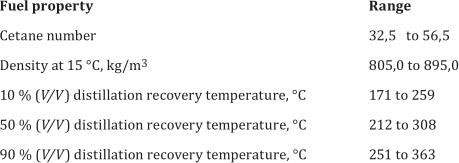WARNING - Use of this document can involve hazardous materials, operations and equipment. This document does not purport to address all the safety problems associated with its use. It is the responsibility of the user of this document to take appropriate measures to ensure the safety and health of personnel prior to application of the document and to determine the applicability of any other restrictions for this purpose.
1 Scope
This document specifies a procedure for the calculation of the cetane index of middle-distillate fuels from petroleum-derived sources. The calculated value is termed the "cetane index by four-variable equation". Throughout the remaining text of this document, the term "cetane index" implies cetane index by four-variable equation.
This document is applicable to fuels containing non-petroleum derivatives from tar sand and oil shale. It is not applicable to pure hydrocarbons, nor to distillate fuels derived from coal. Cetane index calculations do not take into account the effects from additives used to enhance the cetane number.
NOTE 1 This document was originally developed using a matrix of fuels, some of which contain non-petroleum derivatives from tar sands and oil shale.
NOTE 2 The cetane index is not an alternative way to express the cetane number; it is a supplementary tool, to be used with due regard for its limitations.
NOTE 3 The cetane index is used to estimate the cetane number of diesel fuel when a test engine is not available to determine this property directly, or when insufficient sample is available for an engine rating.
The most suitable range of fuel properties for application of this document is as follows:

Within the range of cetane number (32.5 to 56.5), the expected error of the prediction via the cetane index equation will be less than +/- 2 cetane numbers for 65 % of the distillate fuels examined. Errors can be greater for fuels whose properties fall outside this range of application.
As a consequence of sample-specific biases observed, the expected error can be greater even when the fuel's properties fall inside the recommended range of application. Therefore, users can assess the required degree of prediction agreement to determine the fitness-for-use of the prediction.
NOTE 4 Sample specific biases were observed for distillate fuels containing FAME (fatty acid methyl ester).
2 Normative references
The following documents are referred to in the text in such a way that some or all of their content constitutes requirements of this document. For dated references, only the edition cited applies. For undated references, the latest edition of the referenced document (including any amendments) applies.
ISO 91, Petroleum and related products - Temperature and pressure volume correction factors (petroleum measurement tables) and standard reference
ISO 3405, Petroleum products - Determination of distillation characteristics at atmospheric pressure
ISO 3675, Crude petroleum and liquid petroleum products - Laboratory determination of density - Hydrometer method
ISO 3924, Petroleum products - Determination of boiling range distribution - Gas chromatography method
ISO 12185, Crude petroleum and petroleum products - Determination of density - Oscillating U-tube method
3 Terms and definitions
No terms and definitions are listed in this document.
ISO and IEC maintain terminological databases for use in standardization at the following addresses:
ISO Online browsing platform
IEC Electropedia
4 Principle
The density at 15 °C and the temperatures at which 10 % (V/V), 50 % (V/V) and 90 % (V/V) are recovered (distillation recovery temperatures) are determined by standard test methods and the cetane index is calculated from these test data using known correlations.



